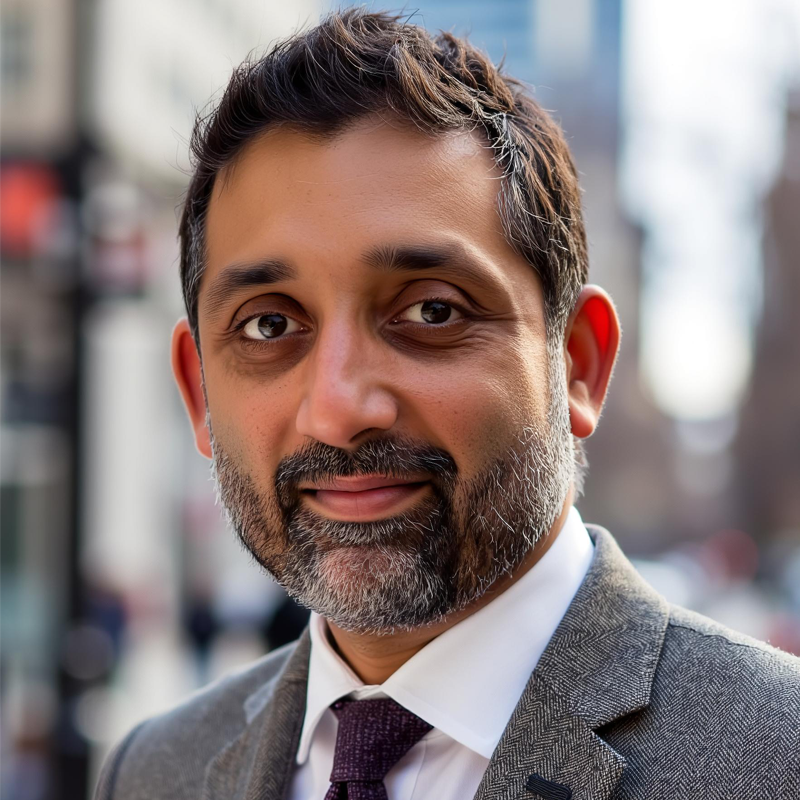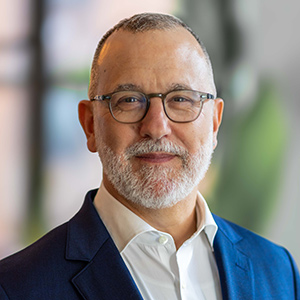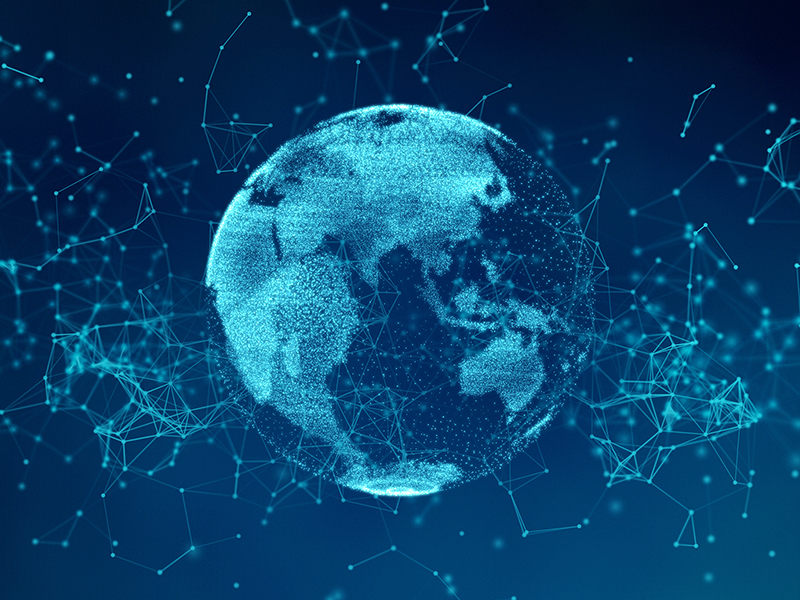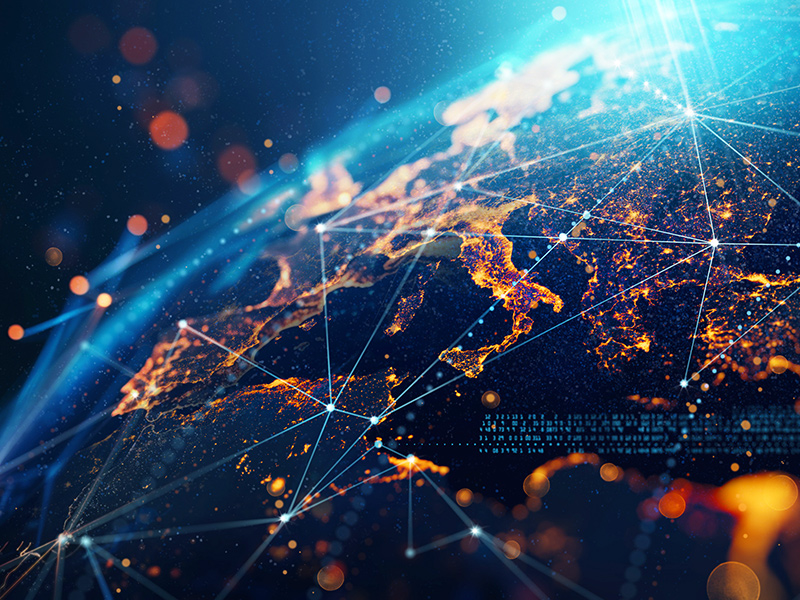Guests
-

Director, Climate and Nature, BSR
Ameer leads BSR’s climate work in the US and works closely with BSR’s Technology sector companies.
Ameer helps BSR members develop strategies to implement the recommendations of the Task Force on Climate-Related Financial Disclosures (TCFD) and enhance business resilience through climate risk assessment using climate scenario analysis and planning. He also works with BSR member companies on developing resilient and sustainable value chains.
Ameer was previously working with BSR’s Financial Services sector companies and led the Business Alliance to Scale Climate Solutions, a BSR carbon markets collaborative initiative now known as the Beyond Alliance.
Prior to joining BSR, Ameer was the chief financial economist at Climate Advisers Trust and Orbitas, where he conducted research on climate scenario analysis and financial research for the agriculture, forestry, and other land use (AFOLU) sector and engaged institutional investors on deforestation risks in investment portfolios. Ameer also brings over a decade of capital markets experience at financial institutions like ABN Amro, Citi, and Barclays Bank.
Ameer holds a MS in Sustainability Management from Columbia University and a BA in Economics and Government from College of William and Mary
Recent Insights From Ameer Azim
- BSR Climate Scenarios 2025 / May 15, 2025 / Reports
- Charting the Course: Navigating the Climate Transition Plan Landscape / February 20, 2025 / Reports
- Climate Scenario Analysis: It’s about More than CSRD Compliance / July 3, 2024 / Blog
- The Environmental Impacts of AI / June 4, 2024 / Audio
- A Business Guide to Responsible and Sustainable AI / March 27, 2024 / Insights+
-

Managing Director, Marketing and Communications, BSR
David leads BSR’s marketing and communications initiatives, working with a global team to amplify the organization’s mission and showcase its activities, impacts, and thought leadership to members, partners, and the wider business and policy community.
David previously worked for The B Team, a group of global business and civil society leaders working to catalyze a better way of doing business for the well-being of people and the planet. Throughout his 20-year career, he has worked with businesses and nonprofits in economic development, public health, and sustainability to define and communicate their purpose and impacts. .
He has built high-impact communications campaigns for a collaboration to improve maternal health in Zambia and Uganda, driven top-tier media coverage for a major economic development project in upstate New York, and helped strengthen parliamentary capacity and voter education efforts in South Africa and Zambia. He began his career as a newspaper reporter.
David earned his M.A. from The Elliott School of International Affairs at the George Washington University and his B.A. in Journalism and Political Science from Michigan State University.
Recent Insights From David Stearns
- A Year of Uncertainty: Maintaining Progress Amidst a Battle of Ideas / February 13, 2025 / Audio
- A Conversation with Mario Abreu, Group VP, Sustainability, Ferrero / February 6, 2025 / Audio
- A Conversation with Darsh Myronidis, Group Director of Sustainability, Virgin / January 8, 2025 / Audio
- Reflections from Climate Week NYC: The Tension Between Pragmatism and Ambition / October 1, 2024 / Audio
- Navigating U.S. Election Uncertainty: A Call to Action for Sustainable Business / August 1, 2024 / Audio
Description
Ameer Azim, Climate Change Director, chats with David Stearns on the Environmental Impact of AI, exploring:
- Why it’s important to assess the environmental impacts of a technology like AI.
- Through what type of activities or upgrades does the use of AI increase a company’s CO2 emissions?
- Beyond carbon emissions, what are some of the other environmental impacts associated with the rise of AI that companies should anticipate dealing with as they embrace this technology?
- What are some of the steps that companies can take to address these negative impacts?
- Can AI be used to combat climate change?
Listen
Transcription
David Stearns:
Welcome to BSR Insights. I'm your host, David Stearns. In this series, we'll be talking to BSR experts from across our focus area and industry teams to discuss the environmental and social implications and opportunities arising from the increasing development and deployment of artificial intelligence in the global economy. I'm joined today by BSR Climate Change Director Ameer Azim, who leads BSR's climate work in the United States. Thank you for joining us today, Ameer. It's great to see you.
Ameer Azim:
Thanks for having me, David.
David Stearns:
So I wanted to start with a broad question at the top, I think it should be fairly easy, just to understand why is it important for companies to assess the environmental impacts of a technology like artificial intelligence?
Ameer Azim:
Thanks for asking that. I think it's a really important question, but unfortunately the equation on AI is not simple to understand. We may think it's only computational power or the energy associated with it, but to understand the impacts of AI, we have to look at the full value chain. The fact is AI will contribute to three out of the nine planetary boundaries, radiated forcing, climate change, land system change, and freshwater change, and we're creeping up on these boundaries fast, and the sooner we start to understand and manage these impacts, the better it will be for us.
David Stearns:
So that's interesting. I think when many people look at the growth of AI from an environmental sustainability perspective, the first place they probably go to is they assume that the use of AI will increase the company's carbon footprint. You've obviously talked about many of the other environmental impacts, but maybe we'll start at the carbon side of it. Through what types of activities or upgrades does the use of AI increase a company's CO2 emissions?
Ameer Azim:
To assess the full impact and the full footprint of AI, we really have to start by looking at the impact much further up the value chain. Think about all of that industrial activity that is required to manufacture the components that AI needs. And we've seen this, we've seen this happen before. Graphic cards once upon a time were only for video games. Then crypto came along and we saw a lot of production of graphic cards specifically for crypto mining. What that has done is really increased the economic activity for big companies like AMD and Nvidia, but at the cost of higher emissions, higher emissions in the mining phase, higher emissions in the manufacturing phase. And both of these phases are highly carbon intensive. We really have to think about the greater impact that this causes both to our carbon budget and the environment more generally. There's no doubt that chip manufacturers have gotten more efficient.
In computer processing units, we used to have a much larger architecture, and now that has been brought down massively, making it more efficient. But also companies are producing more chips. So it's a balancing act. At the moment, GPUs are not at the phase that CPUs were, and we're creating a lot more emissions in both the mining and the manufacturing phase. These GPUs are extensively now used for AI training. This is a parallel computation that is much needed for the type of tasks that AI is suited for. So definitely much further upstream is a big chunk of those emissions. There are also increased emissions associated with running these AI models, especially through the training phase, but also through the inference phase, which follows the training phase. And where does that energy pressure or energy emissions go to? That puts pressure on the amount of server capacity that we have, the amount that these servers draw from the grid.
And the fact is, greening the grid has been very difficult as is. The power sector needs to forerun all other sectors, and now suddenly we have this massive new demand coming from AI, coming from other activities including crypto mining that are going to need more and more servers, and these servers will require energy that we haven't seen before. Just to give you an example, the state of Georgia has had projections that they were working towards, but now revising all of these forward-looking trends, new energy demand is projected to go up 17 times of what they had originally planned. So there are many examples of this across the U.S., across Latin America, across the developing world. Where these servers are placed, grids are not ready for the renewable energy to offset. That use is not available. So largely the carbon emissions are attributed to the energy use, which are scope two emissions.
David Stearns:
So coming back to the top, you had also mentioned some of the other environmental impacts of AI that may not be the first to come to people's mind when they may think of carbon emissions first. You mentioned freshwater use. You mentioned land use more generally, associated I assume with the construction of facilities, some of the elements of the value chain. Can you talk a little bit more about some of the other environmental impacts associated with the rise of artificial intelligence and the types of issues that companies should be anticipating dealing with as they embrace the use of AI more and more?
Ameer Azim:
Absolutely. I think with AI, we have to think about the infrastructure, which is servers. And if you think about servers, then what we really have to start worrying about is the massive amounts of water that are required to cool them. And I was just reading the other day, doing some research for this podcast, among other things, and a midsize server, not a large server, think about a midsize server, it requires 300,000 gallons of water a day. A day, imagine that. And to put that in perspective, that would take care of 100,000 homes. So the immense pressure on water, a resource which is scarce already, really brings this subject to the front of the mind and it really starts to capture the whole impact that AI may possibly have going into the future.
I will also say that we've already seen locations where communities like farmers, for instance, in Texas, have brought these issues up about water use because there are competing priorities for the same amount of water. And Seattle and Oregon, this is now being elevated in the courts. And so the more there is growth of servers and the more dense and intense they get, the more water that they will require. And there's no easy solution to this. We can use air cooling, but air cooling in itself is also inefficient. Air-cooled servers use more electricity per rack of server than anything. A high-performing rack can use as much as 40 kilowatts. So it's not a solution. Replacing water with air is not a solution. We have to think around that problem.
In terms of land use, as we see the proliferation of AI, we're going to need more data centers. Data centers were originally located near tech hubs, but now the top reason for data center site selection are energy availability and land simply land. What that means is that we're going to have to convert forests, we're going to have to convert farmland, we're going to have to mess around with desert ecosystems, and this can have a massive impact, massive impact from the emissions created because of land use change, massive impact because of biodiversity changes. The second, the biodiversity change, this is more relevant now than ever. We have seen biodiversity populations decline massively around the globe because of habitat fragmentation, because of the increased water consumption that disrupts ecosystems because of data servers. The land use conversion itself is the largest, biggest drivers of biodiversity loss. So anything contributing to that should be looked at very, very carefully.
David Stearns:
So you've talked so far quite a bit or almost exclusively on the impacts that really stem directly from company operations. Are there items to take into consideration when it comes to AI in terms of the impacts that might occur further downstream? So, for example, AI making it more efficient for speeding up fossil fuel extraction and the way that AI is actually being used in the marketplace, having its own impacts on the environment. Is that another thing that companies need to be considering in the deployment of AI?
Ameer Azim:
Absolutely. I think you have shared one example of where AI may lead to extending our reliance on oil and gas, and it is enabling activities like efficient exploration and extraction, but also it is elongating our dependence on energy consumption, energy consumption that we don't have a solution for. We need these servers to be reliable, we need there to be zero downtime, and when you need energy for that kind of activity, you need a solid base load. Base load, unfortunately, as we speak, cannot be satisfied with the renewables. It has its implications on the negative side, but when I start thinking about, and we all should start thinking about use of AI further downstream, we should fall back on some of the principles that we've already learned in carbon emissions. Somebody else's scope one and scope two are your scope three.
So ultimately all of what I have mentioned is much the same thinking. It is the same value chain impacts. Someone using a business using AI to better their process or create a product around it, ultimately has to account for all of their upstream emissions. There is no difference in this thinking and we have to practice a responsible and measured approach when we're thinking about downstream applications.
David Stearns:
The conversation so far is focused quite a bit on some of the negative implications of AI from an environmental perspective. We've talked about the carbon emissions, water use, land use. I want to start to pivot now more towards some of the solutions at our disposal here and maybe hear a little bit from you, Ameer, about how companies can begin to address these impacts to hopefully reduce the impacts. And then beyond that, to start to think about what are some of the potential positive impacts of the use of AI and in what ways can AI help our journey to create a more just and sustainable world? So let's start with, what are some of the first steps that companies can take to start to address some of the impacts that you've highlighted for us?
Ameer Azim:
At the high level, I see five important steps for all decision makers when deciding to utilize AI or build AI for their company use. The first is start off by really questioning if AI is really needed, or is it something that can be managed without? Don't fix something that's not broken. Second, I would say, evaluate AI through the environmental lens and the human rights lens as well because it has a lot of implications, unforeseen implications on the way that the labor force will evolve going forward. The next thing I would say, upscale teams to ask the right questions. Product managers are not experts. They don't know the intricacies of models, of AIs, of the different phases and how the process can be bettered. So they need to ask the right questions. They need to have good foundational knowledge to get a good grasp on what's happening and ask the right questions.
Know what energy is used to train the model. I think a lot of models out there, large language models are incredibly intensive and to know or at least have a sense of the scale is very, very important. For those more intricately involved companies that want to build AI models from the bottom, I think many things, there's research constantly going on in this space, but I would encourage them to really see what else other researchers are suggesting. Some of the things that are being talked about are things like efficient architecture, mixture of experts. These are essentially efficiencies that can be found in dense models. They're called MOEs, and companies should research that.
Another big one that a lot of the researchers are pointing to is sparsity, sparsity in the network.
Deep learning networks are incredibly dense, they require a lot of thinking, and all of this activity that is happening in the learning phase where they're looking at questions, pictures, videos, insights, it requires a lot of thinking. It's not a very efficient process, unlike the human brain, which is very efficient. Think about sparsity in the network when we're thinking about that.
Another tactic that companies can use is thinking about optimal trade-off, optimal trade-off between the data size that you have for the model versus the model size of the model. All of that has implications on the computational budget that a model is going to take. And then efficient inference. There's something called distillation, thinking about bigger models for one step. Instead of using large language models for the whole workflow, think about training smaller models from the outputs of a large one. In that process, you can drive down the absolute emissions that are generated by the whole process.
David Stearns:
That's a great place for companies to start, and it sounds like there are a number of places where companies can actually drive some activities that will improve the sustainability of the use of this important technology. With that in mind, as someone who has devoted his career to sustainable business, I'm curious, Ameer, what actually excites you about the use of AI in combating climate change, for example. I mean, the potential of this technology we hear is vast across a number of different challenges facing humanity. I'm curious to hear, what elements of AI get you excited in terms of how it might help us to address some of the challenges that we're facing?
Ameer Azim:
That's a great question, David, and there's a long list of things. I think climate change, just because I'm a climate change expert at BSR, I'll speak to that. Climate change is the generational challenge. It's the challenge, and probably will continue to be for at least a generation after us, if not more. And there's a lot of things that we haven't gotten a handle on quite yet. We do certain things really well, but there are certain things that we weren't able to do in the past. So think about carbon footprinting, scope three footprinting, things like data collection, data cleaning, analysis of that data, management of that data. There's a company called CO2 AI, which is a spin out from BCG, and that is using AI for this exact purpose. That is one application that I see that's very, very exciting for scope three emissions, and it overcomes some of these challenges that we faced with data collection of scope three emissions.
It's also things like reducing emissions through information gathering, through inference or prediction and optimization. Just the optimization of certain processing and things can bring about mitigation of 5% to 10% of global annual emissions. That's massive. We talk about planting trees and halting deforestation. This is on that scale. When we think about geospatial mapping, again, jumping from deforestation, a lot of companies have commitments, a lot of nations have commitments, and AI can really be deployed in that geo-sensing and geo-spatial mapping of our tropical forests or more generally of our forests. And land use changes as well. So I think that's where I see a lot of it being deployed now, where I am really, really excited and I think it can help us get over some of those hurdles and some of those challenges that we've really grappled with and not come to a solution up to now.
David Stearns:
Thank you for that, Ameer. So we like to end all of our conversations with a question about, what do you see coming around the corner, particularly for rapidly growing technology like GenAI? So I'd be curious to hear what you see coming around the corner and then maybe a parting thought on what companies should be paying close attention to in the near future from an environmental perspective.
Ameer Azim:
I think what is getting me really excited is two things. One, not connected to AI, that regulation is finally catching up. We are seeing a lot of jurisdictions ask companies about their plans, their climate transition plans, what they intend to do about their emissions. If I were to see around the bend, I can see that investors are going to have a difficult time really consuming all of this information that is going to come out. They're going to have a difficult time comparing one company with the other, especially some of those big, let's take public mutual funds, for instance, that have many companies in there. And what I do see in AI is a solution to this. AI can help us really take that information and compare some of these plans and really get the pertinent information out. Just thinking about it, I think for a financial analysts, that would've been a big lift.
I think AI can really contribute towards alleviating that in the future, and already, as we speak, that's going on. We're not quite there yet because AI models are still in their infancy. In fact, disclosure against climate transition plans is also in its infancy. So we have some runway and as CTPs, or climate transition plans, scale, I hope that AI is going to be much further along to help us with that. Generally speaking, I think what I would advise companies is, companies should be aware of the use of AI having significant climate and environmental concerns. Just like the things we spoke about, energy use, increased emissions, increased water use, increased land use, they need to keep that top of mind. They need to think, accept, and in fact invest in tools that are powered by AI to solve climate and solve nature.
These crises are going to need better data, better analysis of that data, better predictions, better automation, optimization, and visualizations for us to understand the whole process. And then I will say, and maybe this is not a subject for me to speak at length, and there are going to be other colleagues who are going to speak to that, but redefining responsible AI. Responsible AI needs ethical guardrails, and companies should think about these even before embarking on an AI project, and my colleagues will address that in subsequent talks.
David Stearns:
Well, that was a lot for us to think about, and I suspect that this is a topic that's not going to be leaving us anytime soon. So, Ameer, hopefully we'll be in touch again and have you back on to talk a little bit more about the responsible use of AI, but thank you so much for joining us.
Ameer Azim:
Thanks for having me.
David Stearns:
Thanks for listening. For more in-depth insights and guidance from BSR, please check out our website at bsr.org and be sure to follow us on LinkedIn.
BSR’s latest sustainability insights and events straight to your inbox.
Topics
Let’s talk about how BSR can help you to transform your business and achieve your sustainability goals.







